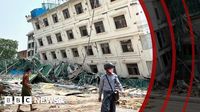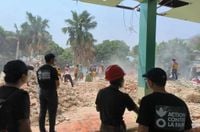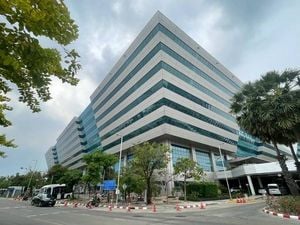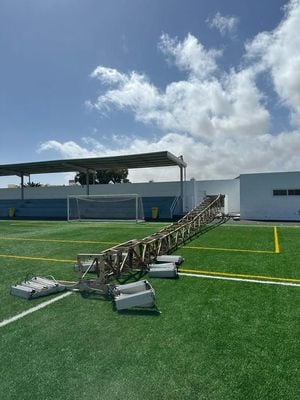Driving into Mandalay, the devastation from the earthquake that struck on March 28, 2025, is starkly visible. The destruction is pervasive, with at least one building collapsed on nearly every street, particularly in the northern and central parts of the city. Many structures are left with visible cracks, rendering them unsafe for occupancy. The main city hospital has resorted to treating patients outdoors due to the overwhelming demand and damage to its facilities.
Among those anxiously awaiting news is Nan Sin Hein, a 41-year-old woman who has spent five days outside a collapsed five-story building, hoping for word about her 21-year-old son, Sai Han Pha, a construction worker trapped inside. "I have hope that he's alive, even if it's a small chance," she told reporters. The building, which was undergoing renovations, crumbled during the earthquake, trapping Sai Han Pha and four other workers beneath the rubble.
As of April 2, 2025, rescue efforts at the site have not yet begun, and the lack of immediate assistance is evident. The country, already in turmoil due to a civil war that has displaced an estimated 3.5 million people, is struggling to respond effectively to this latest disaster. The military junta, which has ruled since the coup in February 2021, is reportedly too stretched to deploy adequate resources for rescue operations.
Despite the dire need for help, the military government has issued a rare appeal for international assistance. However, the relationships with many foreign nations remain strained, limiting the support that can be provided. Aid is currently being offered mainly by India, China, and Russia, focusing on critical locations like the Sky Villa condominium complex and the U Hla Thein Buddhist academy, which collapsed during the quake.
Neeraj Singh, leading the Indian disaster response team at the Buddhist academy, described the building's collapse as resembling a "pancake," indicating the severe difficulty in finding survivors. "It's the most difficult collapse pattern and the chances of finding survivors are very low. But we are still hopeful and trying our best," he said.
Rescue teams face extreme conditions, with temperatures soaring to nearly 40 degrees Celsius. The work is slow and laborious, as rescuers use drills and cutters to break through concrete slabs. The stench of decay is overwhelming as bodies are discovered, and families wait anxiously for news. The father of 29-year-old U Thuzana expressed his despair, saying, "Knowing my son ended up like this, I'm inconsolable, I'm filled with grief." The emotional toll on families is palpable as they gather around ambulances, hoping for a glimpse of their loved ones.
Many of Mandalay's historical sites, including the Mandalay Palace and the Maha Muni Pagoda, have also suffered significant damage. The oppressive environment created by the military junta makes access to collapse sites and victims' families challenging, as many people fear speaking to journalists.
Buddhist funeral rituals are being held on the streets, with families mourning the loss of loved ones. U Hla Aung Khaing and his wife, both in their sixties, were found two days after the earthquake, their bodies discovered by locals using rudimentary equipment. The military government reports that 2,886 people have died so far, but this figure is likely an undercount, as many collapse sites remain unreached.
As the city grapples with the aftermath, parks and open spaces have turned into makeshift camps for those displaced. Many residents are opting to sleep outdoors, fearing aftershocks that have continued to rattle the region. Daw Khin Saw Myint, a 72-year-old woman, described her plight: "I don't know what to think anymore. My heart still trembles when I think of that moment when the earthquake struck. My house is gone. I'm living under a tree. Come and see. We don't have anyone to rescue us. Please help us." Her words reflect the desperation felt by many in Mandalay.
Food and water shortages are rampant, as most vehicles delivering supplies are small vans with limited stocks. The local hospital, already overwhelmed, has been forced to treat patients outdoors, with many families stepping in to provide care. Shwe Gy Thun Phyo, a 14-year-old girl with a brain injury, and Zar Zar, suffering from severe abdominal injuries, are among those receiving inadequate care due to a lack of medical staff and resources.
As the window for finding survivors narrows, the number of deceased being brought into hospitals increases. Nan Sin Hein's hope for her son dwindles as she prepares for the possibility of facing the worst. "I'm heartbroken. My son loved me and his little sisters. I want to see his body. I want them to do everything they can to find his body," she lamented.
In the wake of the earthquake, the Catholic Church has emerged as one of the first responders, attempting to mobilize aid through Caritas Myanmar. However, they face significant obstacles, including military checkpoints and confiscation of supplies. A priest from the Diocese of Loikaw explained, "The Church is also trying to help, but we encounter countless obstacles. We can’t freely access the affected areas because there are military checkpoints everywhere."
Despite the dire circumstances, there is a growing call for a ceasefire to facilitate rescue efforts. Cardinal Charles Maung Bo, the archbishop of Rangoon, has made appeals for peace, but these have largely gone unheeded amidst the ongoing conflict. The situation remains critical, with many communities in desperate need of assistance.
As international aid begins to trickle in, the challenges of delivering it remain daunting. Lisette Suárez from Action Against Hunger noted, "The distribution of humanitarian aid has also been hampered because many roads and main thoroughfares have been completely destroyed." The need for clean water, food, and medical assistance is urgent, and the psychological impact of the disaster is profound.
Despite the overwhelming adversity, the resilience of the people in Myanmar shines through. The priest from Loikaw summed it up well: "Our faith remains strong. Despite the difficulties, we remain united, praying, and helping one another. We cannot lose hope that better days will come." The road to recovery will be long and fraught with challenges, but the spirit of the people endures.






